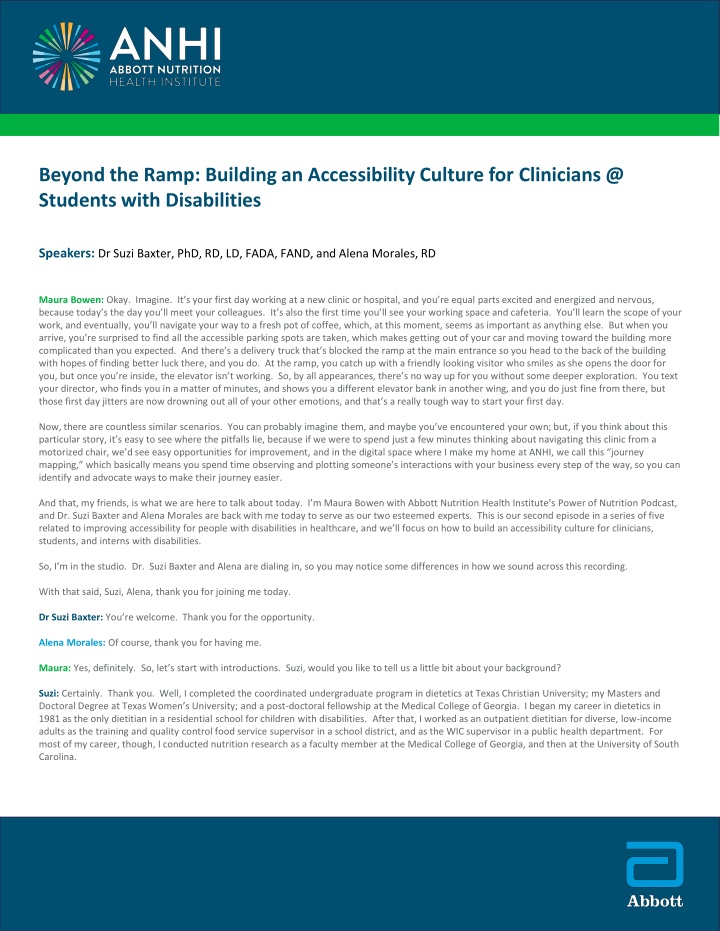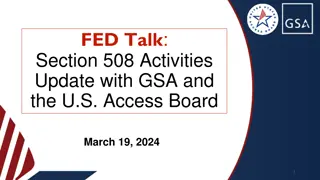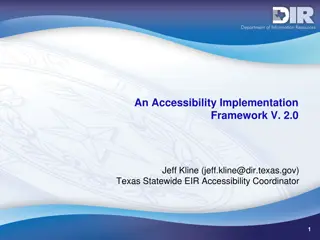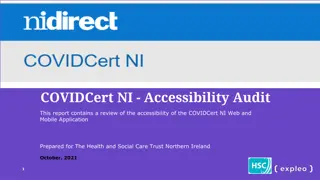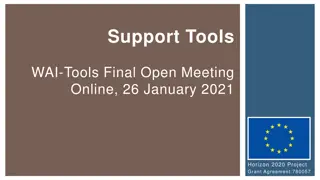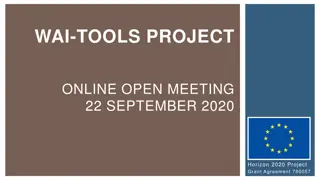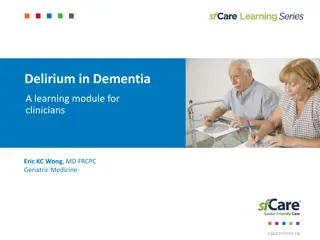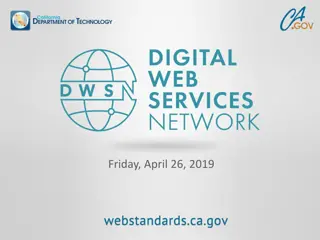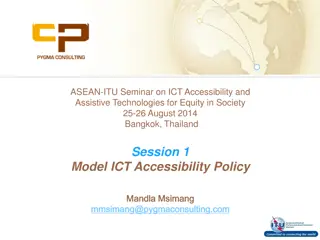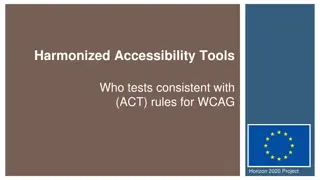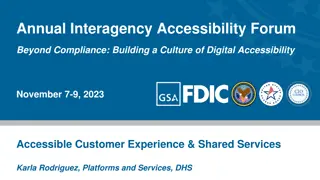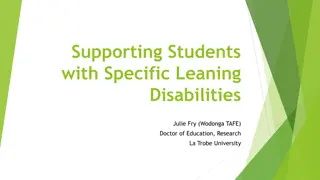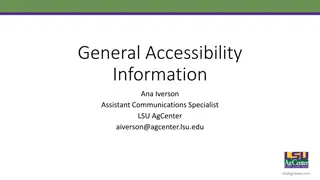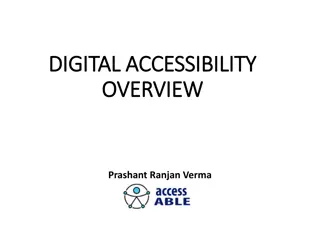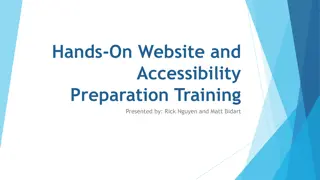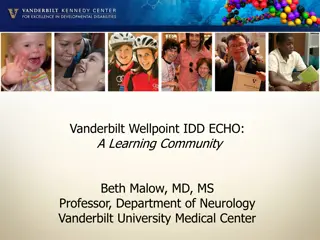Building an Accessibility Culture for Clinicians & Students with Disabilities
Imagine starting a new job at a clinic only to face accessibility challenges like blocked ramps and non-functional elevators. In this podcast episode, experts Dr. Suzi Baxter and Alena Morales discuss the importance of creating an inclusive environment for clinicians, students, and interns with disabilities. Dr. Baxter shares her journey with an acquired disability, highlighting the need for a culture that supports individuals with diverse needs in healthcare settings. Their insights aim to inspire awareness and actionable steps towards improving accessibility in the healthcare industry.
Download Presentation

Please find below an Image/Link to download the presentation.
The content on the website is provided AS IS for your information and personal use only. It may not be sold, licensed, or shared on other websites without obtaining consent from the author.If you encounter any issues during the download, it is possible that the publisher has removed the file from their server.
You are allowed to download the files provided on this website for personal or commercial use, subject to the condition that they are used lawfully. All files are the property of their respective owners.
The content on the website is provided AS IS for your information and personal use only. It may not be sold, licensed, or shared on other websites without obtaining consent from the author.
E N D
Presentation Transcript
Beyond the Ramp: Building an Accessibility Culture for Clinicians @ Students with Disabilities Speakers: Dr Suzi Baxter, PhD, RD, LD, FADA, FAND, and Alena Morales, RD Maura Bowen: Okay. Imagine. It s your first day working at a new clinic or hospital, and you re equal parts excited and energized and nervous, because today s the day you ll meet your colleagues.It s also the first time you ll see your working space and cafeteria. You ll learn the scope of your work, and eventually, you ll navigate your way to a fresh pot of coffee, which, at this moment, seems as important as anything else. But when you arrive, you re surprised to find all the accessible parking spots are taken, which makes getting out of your car and moving toward the building more complicated than you expected. And there s a delivery truck that s blocked the ramp at the main entrance so you head to the back of the building with hopes of finding better luck there, and you do. At the ramp, you catch up with a friendly looking visitor who smiles as she opens the door for you, but once you re inside, the elevator isn t working.So, by all appearances, there s no way up for you without some deeper exploration. You text your director, who finds you in a matter of minutes, and shows you a different elevator bank in another wing, and you do just fine from there, but those first day jitters are now drowning out all of your other emotions, and that s a really tough way to start your first day. Now, there are countless similar scenarios. You can probably imagine them, and maybe you ve encountered your own; but, if you think about this particular story, it s easy to see where the pitfalls lie, because if we were to spend just a few minutes thinking about navigating this clinic from a motorized chair, we d see easy opportunities for improvement, and in the digital space where I make my home at ANHI, we call this journey mapping, which basically means you spend time observing and plotting someone s interactions with your business every step of the way, so you can identify and advocate ways to make their journey easier. And that, my friends, is what we are here to talk about today. I m Maura Bowen with Abbott Nutrition Health Institute s Power of Nutrition Podcast, and Dr. Suzi Baxter and Alena Morales are back with me today to serve as our two esteemed experts. This is our second episode in a series of five related to improving accessibility for people with disabilities in healthcare, and we ll focus on how to build an accessibility culture for clinicians, students, and interns with disabilities. So, I m in the studio. Dr. Suzi Baxter and Alena are dialing in, so you may notice some differences in how we sound across this recording. With that said, Suzi, Alena, thank you for joining me today. Dr Suzi Baxter: You re welcome. Thank you for the opportunity. Alena Morales: Of course, thank you for having me. Maura: Yes, definitely. So, let s start with introductions. Suzi, would you like to tell us a little bit about your background? Suzi: Certainly. Thank you. Well, I completed the coordinated undergraduate program in dietetics at Texas Christian University; my Masters and Doctoral Degree at Texas Women s University; and a post-doctoral fellowship at the Medical College of Georgia. I began my career in dietetics in 1981 as the only dietitian in a residential school for children with disabilities. After that, I worked as an outpatient dietitian for diverse, low-income adults as the training and quality control food service supervisor in a school district, and as the WIC supervisor in a public health department. For most of my career, though, I conducted nutrition research as a faculty member at the Medical College of Georgia, and then at the University of South Carolina.
Suzi: It was 2010 when I was diagnosed with my acquired disability, Erythromelalgia, which is a rare, neurovascular condition which most commonly affects the feet, but also affects the hands, face, or other body parts. Hallmark symptoms are excessive redness due to excessive blood flow to the area, and pain which ranges from mild tingling to severe burning. I worked for six years after my diagnosis by spreading my 40-hour work week over all seven days and telecommuting from home most of the time. But I simply was unable to e keep up with the workload and had to resign my research professor position at the end of 2016. Maura: Thanks for sharing that, Suzi. And how about you, Alena? Alena: Yes, so my experiences with disability began very young, around 12 years old. I developed several chronic illnesses, and later endured a car accident that have affected my mobility, pain, nutrition, and more. For a few years, I mostly identified with the chronic illness community, but I started identifying as disabled in high school when I started using a wheel chair, a central line for IV infusion, and a service dog to navigate life. I came across the disability rights movement in its roots within Berkley, California, and this, of course, inspired me to go to UC Berkeley for college studying dietetics and disability studies. While at Berkeley, I participated in the disability community, there through many hats. First, I worked for the Disability Access and Compliance Office to help optimize physical, technological, and programmatic access for affiliates with disabilities. I also engaged in disability activism by creating new organizations, developing wellness programs for students with disabilities, and creating one of the first disability cultural centers in the country. I later joined a three-year research program at University of California San Francisco. And there, we analyzed the impact of SNAP, um SSI, and SSDI recipients. In 2021, I continued my education at Berkeley by attending their clinically focused. Individualized Supervised Practice Pathways, or ISPP, for short. And then later, I received my R.D. in 2022, and now I primarily work as a clinical dietitian at Palomar Medical Center in San Diego, in the in-patient and long- term care setting. Maura: Well, excellent, and thank you both for sharing your background. It s really helpful to have that for context for this conversation. Now, for those listeners who may not know, can you give us a brief overview of some legislation designed to support people with disabilities? Alena: Sure. So, the Rehabilitation Act prohibits discrimination on the basis of disability in programs that are conducted by federal agencies, in programs receiving federal financial assistance, and in federal employment, and the employment practices of federal contractors. So, as of now, the regulations in the Rehab Act are separated into five major sections: Section 501, 503, 504, 505, and 508. The passage of this first Disabilities Civil Rights law, which is Section 504 of the Rehab Act of 1973, marked a cultural shift in the US, because a validated disability is a social class for the first time in federal policy. So, rather than segregation and discrimination of disability being seen as this inevitable result of the impairment, it s suggested that was imposed by a barrier that needed to be eliminated. This was, of course, a win for the community, but as you may have guessed, there was still a need for additional civil rights protection for people with disabilities in all environments. Fast forward to a rich and storied 15 years or so of tenacious, fiery disability advocacy when the Americans with Disabilities Act was formed. The Americans with Disabilities Act, or ADA of 1990, is a law to ensure that people with disabilities have the same rights and opportunities as everybody else. This law prohibits discrimination against people with disabilities in all public life areas, including job, schools, transportation, and venues open to the general public. The ADA is divided into five sections, or titles, relating to public life: Title I is employment; Title II is public entities including public transportation; Title III is public accommodations, including commercial facilities; Title IV is telecommunications; and Title V is just miscellanea. Now, over the years, disability legislation has been amended to include protections for people in an ever-evolving, technologically advancing world. We want to mention several affected entities in this podcast series. In September 2023, US Department of Health and Human Services issued a proposed rule over Section 504, to advance equity and bolster protection for people with disabilities. Now, this proposed rule provides the best civil rights to ensure that people with disabilities are not subjected to discrimination in any program or activity receiving funding from the US Department of Health and Human Services just because they have a disability.
While the Department is undertaking this rule-making, the current regulation is, in fact, in effect. Now, this proposed rule clarifies several crucial areas that are not explicitly addressed in Section 504. A few relevant clarifications will include medical treatment decisions by entities that receive federal financial assistance from the US Department of Health and Human Services, are not based on bias or stereotypes about individuals without disabilities, judgments that an individual would be a burden on others, or beliefs that the life of an individual with a disability has less value than the life of a person without a disability. Suzi: And to continue on what Alena is sharing, this proposed rule to Section 504 will help entities that receive federal financial assistance from the U.S. Department of Health and Human Services to better understand and comply with their obligations under Section 504, and provide more detail about the right to be served in the most integrated setting appropriate for individuals with disabilities. The proposed rule incorporates changes needed to reflect amendments to Section 504, enactment or enforcement of the Americans with Disabilities Act, and significant case law. Most entities that receive federal financial assistance from the U.S. Department of Health and Human Services have been covered by the Americans with Disabilities Act since 1991. New sections added to ensure consistency from these entities concern various accommodations, including service animals, mobility devices, maintenance of accessible features, communications, policies and procedures compliant with the 2010 Standards for Accessible Design, and much more. Now, I have to share that, when the proposed rule came out for the revisions, I was surprised and dismayed to find nothing in them about medical nutrition therapy for people with disabilities. People with disabilities need medical nutrition therapy for their specific disabilities, as well as the other chronic diseases they can acquire, such as diabetes, heart disease, cancer, and high blood pressure, just like people without disabilities. And the public comment period was open for 60 days for the public to provide comments on this proposed rule to Section 504. Thousands of comments were received, including many from the Consortium for Constituents with Disability. Now, I mention this Consortium because it s the largest coalition of national non-profit organizations working together to advocate for a broad range of federal public policy that ensures the self- determination, independence, empowerment, integration, and inclusion of people of all ages with disabilities, and their families, in all aspects in society. This consortium works to achieve federal legislation and regulations that assure that the millions of children and adults with disabilities are fully integrated into the mainstream of society. A Consortium s public policy work is conducted by its 17 task forces, and one of these 17 task forces is health. Now, this consortium has approximately 100 member organizations, including many organizations for medicine and disability. Now, the Academy of Nutrition and Dietetics is not currently a member, but I have requested that they apply to join this Consortium. I encourage you to check if your health organization is a member, and if it s not, please ask them to join. The annual dues are $775.00. And, I want to mention one other thing, as Alena mentioned that these revisions to the Section 504 were proposed in September of last year. September of 2023 was a hallmark month, because that was the same month that the National Institutes of Health identified the people with disabilities as an under-represented group. Why is this significant? Well, this means that there will be more research now from the National Institutes of Health and all the grants that it awards and cooperative agreements that it awards, so that there will be more research including people with disabilities, and that is very crucial and very much needed. Maura: And thanks very much for that history. It s really clear that we ve come a long way in that period of time, but there s legislation, and, of course, there s the application of that legislation. So, I wanted to ask whether you have mobility challenges or you have trouble with sight or auditory function, or you re neuro-divergent, or you face other challenges in your physical and digital setting, what are some of the major considerations for providing clinicians with disabilities the right accommodations in their workplaces? Suzi: Job accommodations play a key role to create inclusive work places to advance the goals of the Americans with Disabilities Act and increase employment opportunities for people with disabilities. Healthcare practitioners are among a significant proportion of people who are either born with, or acquire, a disability over the course of their lives. From the patient s perspective, more healthcare practitioners with disabilities have the potential to improve the patients outcomes and clinical experiences.That s because practitioners with disabilities generally have more insight and understanding of the culture, food traditions, and health challenges of patients with disabilities. They re often better equipped to gain their patients trust to facilitate the positive changes to result in better outcomes from health therapy.
Suzi: For employees and job applicants with disabilities, employment provisions of the Americans with Disabilities act apply to private employers with 15 or more employees, to state and local governments, employment agencies, labor unions, employer agents, and joint management labor committees. This means that hospitals must abide by the employment provisions too. Furthermore, the rules for Section 503 of the Rehabilitation Act of 1973, which took effect in 2014, mandate that federal contractors include disability in their recruitment and hiring strategies. This means that hospitals and other federal medical facilities should intentionally be seeking and hiring qualified people with a disability. Now, qualified means that they meet the requirements of specific job positions irrespective of whether they have a disability. In other words, people with disabilities are not hired simply because they have a disability. Employers to whom the employment provisions of the Americas with Disabilities Act apply must designate specific offices, people or contacts to comply with disability rights laws, such as the Americans with Disabilities Coordinator to ensure that the employer complies with disability laws. And large employers typically also have an Equal Employment Opportunity Office, or EEO, to oversee non-discrimination in hiring in employment. When I acquired my disability, I had already been working for that employer for seven years, and I was hesitant to identify myself as a person with a disability to my employer. I wasn t alone. Most organizations report that their workforce includes very few people with disabilities only four to seven percent on average but there s a new survey with about 28,000 employees that was conducted by the Boston Consulting Group in the summer and fall of 2022 in 16 countries, and this survey found that 25 percent of employees had disabilities. In hindsight, I wish I had talked with my employer s Americans with Disabilities Coordinator, or with its Equal Employment Opportunity office; but, one thing that I did do right was that soon after I started working for this employer, I signed up for long-term disability insurance. And then after I had to resign my research professor position, due to my acquired disability, it was my long-term disability insurance provider who stepped in and protected my rights as an employee with a disability, and paid a large portion of my salary until I turned 65. Maura: Okay, that s really helpful to know about the application in the work place, and I m wondering if we can take maybe our future and our newest healthcare professionals into consideration here too. So, I have a similar question for you: what are the major considerations for accommodating students and interns on campus, and also in healthcare environments? Alena: Yeah, so the Americans with Disabilities Act actually includes provision for post-secondary education institutions concerning accommodations for students with disabilities at both public and private colleges and universities. This includes, but is not limited to: classroom accommodation, dormitory accommodation, digital accommodation, and parking and transportation. The ADA requires that post-secondary education institutions modify their policies, practices, and procedures to allow equal access to students with disability, unless doing so would result in the fundamental altercation of the program or service provided. This law does not ask post-secondary educational institutions to lower their educational standards, but to, instead, provide alternative mode that offer students with disabilities access to the learning environment and opportunities to demonstrate competency. Now, accommodations can get a bit tricky for a dietetic intern, because some dietetic internships consider interns to be employees; others consider them to be students; and, some actually don t consider them to be either of these. Students of disabilities who attend post-secondary educational institutions are protected by Title II of the Americans with Disabilities Act. Interns with disabilities who qualify as employees are covered by Title I of the Americans with Disability Act if they are interns for a covered employer. The key issue is to determine who is responsible for providing these accommodations for interns with disabilities: the post-secondary educational institution, the employer, or both. So, I ll use my personal experience to kind of help you understand the difference in these interactive processes, but the experience of a disabled intern, of course, varies widely. In my internship, I was technically a visiting scholar within my university. Visiting scholars don t receive accommodations directly from the Student Accommodation Office, as they are not paying the student that paid tuition, nor are they paid employees of the university. If I were to receive formal accommodations, I would have had to petition to the Disability Access and Compliance Office, which was a different office than the Student Accommodation Office responsible for providing accommodations not listed in the aforementioned ADA policy. I actually worked there for four years, and I realized that this opportunity for accommodations for visiting scholars was not well-advertised, leading a few visiting scholars to file grievances or undergo litigation due to lack of visibility and access. During my internship, I had already built rapport with the Director of the Dietetics program, and thankfully, she was familiar with the accommodations I received as an undergraduate student. So, I did not
Alena: ...feel the need to undergo formal processes within the Disability Compliance Office in order to receive accommodation. This was beneficial in the sense that I could modify my accommodations throughout the internship as needed without needing to re-engage in the interactive process, but it also meant that I did not receive access to the modified equipment offered by the Accommodations Office, such as wheelchair accessible testing desks and alternative media, which may be beneficial for interns who require this alternative equipment. As a student, I utilized specialized reading apps and accessible desks provided by the DST, but as an intern, the university and therefore, my director, did not have control of the physical accessibility and the culture around disability of the rotation sites that I would do my rotations in, such as hospitals, out-patient clinics, etc., so I actually chose to discuss these with my site preceptors. Most were accommodating and inclusive, but the sites who weren t led to problematic interaction and ableism that impacted my performance and my self-esteem. This seemed like an easier process due to the unknown, however, so I intentionally chose to attend this dietetic internship. If I did not previously attend this university, I, as a disabled intern, would essentially have to disclose my disability to my director in order to figure out which office covered my accommodation. The Americans with Disabilities Act requires educational institutions to keep the disabilities of its students confidential. Offices obtain medical documentation in order to determine optimal accommodations, and professors are handed a list of these accommodations with out disclosing the disability. So, in other words, a professor is not legally entitled to know what your diagnoses are in order to provide these accommodations. This also means that your identity as a student with a disability is kept confidential from other students, so you could essentially be sitting next to a fellow student with an invisible disability, and you would never know that you both receive services from the Accommodations Office. With this in mind, this legal interactive process is undoubtedly different from community building, because it does not facilitate the interaction between affiliates with disability. During my time as an undergraduate student, I noticed a disassociation between disability and legal liability led to gaps in the visibility of disability culture on campus, especially when compared to other marginalized identity groups. Now, I spent five years advocating for the creation of the Disability Cultural Center on campus that was separate from the two compliance offices. This physical space implementing universal design and disability culture to represent a physical space for affiliates with disabilities to feel safe and unapologetically disabled on campus. It also hosted many advocacy groups, disability related clubs, and events for the community to learn, organize and bond. Many affiliates with disabilities self-identified, but did not have any education on disability justice or the medical versus social model. I ll kind of explain this, because it s important to understand these models in order to advocate for yourself in student spaces, employment spaces, and more. So, for those of you who don t know, the medical model of disability identifies the disabling barrier to be the pathological impairment or medical diagnosis, while the social model of disability identifies the disabling barrier to be the inaccessible, inequitable environment. As I mentioned before about Section 504, that was a very influential policy because it finally recognized the social model. I ll briefly repeat a similar example to what I mentioned in the previous episode. The barrier is that I cannot use stairs the barrier is that there is no elevator; or the barrier is not the difference within the individual, but a structural barrier imposed by society that may be physical, technological, or socio-cultural. Although medical diagnoses of people within the disability community are expansive and pose difference experiences, these societal barriers and stigmas, also known as ableism, are often similar, which is why the disability community is identity based and not diagnosis based. Implementing the social model of disability in student spaces is essential for many reasons. (A) it creates a more educated and equitable environment; (B) it helps facilitate disability pride and community during a very impressionable phase of life; and, (C) it encourages students to positively carry knowledge of disability into their workplaces, and therefore, increase equity for people with disabilities everywhere. Maura: So, Alena, I m so glad you brought up social models, because it made me think what can clinicians and healthcare students and interns do to support the social model, which ultimately helps us better support our colleagues with disabilities?
Alena: There are many things you can do. The social model calls for an end to discrimination and stigma towards people with disabilities through things like accommodations, education, embracing disability culture, and universal design. On an individual level, you can support this by educating yourself on the ADA and how it came to be through the disability rights and independent living movement. You may be familiar with the famous Netflix movie, Crip Camp, that recently came out which tells the story of famous disability activists, such as Judy Heumann, for example, and told the story of monumental drive to obtain equal rights through events such as the 28-day Section 504 sit-in; the Capitol Crawl, and more. You can also learn about more of these movements to elevate disability as an intersectional socio-cultural identity by exploring newer ways of disability advocacy, known as disability justice. But I would also suggest you learn so you have a better idea for how to embrace the experiences of your patients by understanding shared barriers could change, for example; how to create accessible meal or cooking plans; and, creating a welcoming patient care environment that the disability community can support. Suzi was on the dot earlier when she said that people with disabilities are very loyal to a brand, job, or service when they find out it s inclusive. We will tell all of our fellow community members to support or not support. Regarding disability cultural competency, I would suggest starting by hiring a disability justice consultant or perusing disability competency models to create training for employees and management within your facility. These trainings may encompass topics such as avoiding disability stereotypes, fostering a safe work environment for employees with disabilities, language tips when engaging with patients with disabilities, and more, depending on the needs of your facility. There are a lot of organizations that provide a good place to start, such as the Disability Rights and Education Defense Fund, Disability Rights Advocates, Health Justice Commons, ADA National Network, World Institute on Disability, and much, much more. And, as accessibility and culture kind of evolve alongside these new technologies and need, they need a disability working group within your organization within Human Resources and perhaps employees with disabilities who are comfortable participating. So, overall, I would encourage any change you make as a provider to be very visible to the disability community. Making access and inclusion visible and apparent sends the message that people with disabilities are welcome in this space, in all capacities, whether you re a patient, provider, student, or intern. Maura: Now, you both have hinted as this a little bit already, but sometimes, it can be tricky to ask for what you need. So, what are some ideas you have that have worked for you, or that you ve heard have worked for others, to help clinicians and healthcare students, and interns with disabilities advocate for their accommodations? Suzi: Excellent question. Well first, as Alena has been sharing, it s very important to remember that, if you have a disability, there are advocates to actually request your accommodations, whether you re a clinician, a student, or an intern.If you re a clinician/practitioner, your accommodations advocate is the Americans with Disabilities Act consultant and/or your Equal Employment Opportunity office at your employer. If you re a student with a disability, your accommodations advocate is the Disability Services Office at your college or university, but remember, students must be registered with this office in order to have this accommodations advocate. If you re an intern with a disability, that s where it gets a bit tricky, and so your accommodations advocate may be the same, because we re the clinician, or the students, or even both, or neither, depending whether your intern has paid by the internship site. These advocates, as Alena said, will keep the details about your disability diagnosis confidential, but they will go to bat for you so you receive the disability accommodations you need to the extent of the law, keeping in mind that the law does specify that the accommodations be reasonable. Alena: Yeah, Suzi described this very well. Going off of that, I would add that you can utilize ADA consultants and EEOC resources prior to receiving employment if you re not sure what you may need in the first place. Now EEOC and Job Accommodations Network web site, which will be discussed in a minute, have wonderful information regarding the overall interactive processes of accommodation, examples of accommodations, and your civil rights. If you re an employer in, let s say, a private practice, you can also receive information in training resources regarding the rights of employees with disabilities. I would also encourage you to utilize organizations that provide accommodations not specific to the classroom or workplace. The Center for Independent Living, for example, is a good place if you need life accommodation to even begin your journey as a clinician, student, or intern.
Maura: Now, while were on the subject of resources and best practices so what resources and best practices can workplaces put into place for clinicians and heath care students and interns? Suzi: Another excellent question, Maura. Well, Alena made an excellent point when she said that disability impacts all aspects of life and disability advocacy continues to help make an impact in all aspects of life. But, if we shift back now to the workplace, as Alena mentioned, the Job Accommodation Network, or its acronym JAN, is the main source of free expert and comprehensive guidance on workplace accommodations. JAN helps employers enhance their workplace by capitalizing on the value of individuals with disabilities. And JAN helps individuals with disabilities improve their employability. JAN offers one-on-one guidance by telephone and online about reasonable accommodations, as defined by the Americans with Disabilities Act. JAN also offers guidance to locate and purchase specific products and equipment for accommodations to make the facilities accessible, and to make the job accessible. JAN s data suggests that more than half of all accommodations cost nothing. I ll repeat that, because it s important. Many people have the false belief that accommodations are going to cost them a fortune. That s not true. JAN s data suggests that more than half of all accommodations actually cost nothing. And oftentimes, it s the person with the disability who can suggest a certain accommodation for them to get the job done. JAN provides A to Z listings by disabilities, topic, and limitation to help employers and individuals determine effective accommodations that comply with Title I of the Americans with Disabilities Act, accommodation ideas, and resources for additional information. It also provides situations and solutions that are real life examples of accommodations that were made by JAN customers. Another resource is the Employer Assistance and Resource Network on Disability Inclusion. Its acronym is EARN, E-A-R-N. EARN supports employers to recruit, hire, retain, and advance qualified individuals with disabilities. EARN s web site is a centralized source of employer focused tools, resources, and publications on disability inclusion. I use the EARN web site a lot. Another resource is the Partnership on Employment and Accessibility Technology, or the acronym, PEAT, P-E-A-T. PEAT is a multi-faceted initiative to promote the employment, retention, and career advancement of people with disabilities by developing, adopting, and promoting accessible technology. PEAT has tool kits for workplace accessibility, specifically for staff training, talent, buying and policy. Another resource is Disability IN. Disability IN is the leading non-profit resource for business disability inclusion worldwide. Its network of more than 220 corporations expand the opportunities for individuals with disabilities across enterprises. Its central office and more than two dozen affiliates raise a collective voice of positive change for individuals with disabilities in business. Disability IN collaborates to promote the full inclusion of individuals with disabilities, to inspire accessible innovation for all, and to foster cultures of inclusion. And, another resource is the Disability Equality Index or DEI. DEI is the leading independent third-party resource with an annual benchmarking of corporate disability inclusion policies and programs. DEI is now trusted by more than 70 percent of the Fortune 100 and nearly half of the Fortune 500 businesses. The next resource that I ll mention specifically concerns internship programs. The Office of Disability in Employment Policy of the U.S. Department of Labor has a very helpful online, how-to guide for employers to create inclusive internship programs. Dietetic internships and preceptors may find this guide helpful to ensure that their internships are inclusive of people with disabilities. The next resource I ll share with you is called Disability Scoop.Disability Scoop is the nation s largest news organization devoted to covering developmental disabilities, with daily coverage of autism, intellectual disability, cerebral palsy, Downs Syndrome, and more. And, Disability Scoop also allows one to search job openings for professionals serving those with disabilities. I have found Disability Scoop to be very useful and very informative. And I ll share one more resource with you now, and I ve saved it for last, because I think it s very crucial. This resource is called the National Council on Disability. The National Council on Disability is an independent federal agency composed of nine members four appointed by Congress and five appointed by the President. So, this council provides advice to the President, Congress, and Executive Branch agencies to advance policy, to promote the goals of the Americans with Disabilities Act, equality of opportunity, economic self-sufficiency, independent living, and full participation in all aspects of society, regardless of type or severity of disability. This council plays a leading role in analyzing the needs of people with disabilities.
Maura: Thank you for explaining, Suzi. And, Im wondering, Alena, from a similar lens, can you talk a bit about some of the accommodations youve found to be helpful for students in a didactic program in dietetics who need to register with the disability services office on their campus or university? Alena: Certainly. So, I will separate this into first talking about classroom accommodations and campus accommodations, and then I ll dive in to some resources that can be used hand in hand with the resources that Suzi just mentioned. So, depending on your disability, there are several types of accommodations that may be helpful when going through your DPD. Some accommodations that may be helpful in any classroom, not just dietetics classroom, include: adjustable height desk to take notes during class, extra time during exams, a note-taker to write out lectures, clearance to eat snacks during class, live CART captioning of lectures, image and video description during lectures, clearance to sit on the floor or use din toys during class, usage of a computer or other assisted technology, clearance to bring a service animal to campus the ADA, by the way, allows dogs and mini horses to be brought to campus a scribe to assist during exams, and much more. In specialized dietetics classes, you may require accommodations for the laboratory or teaching kitchen, such as a lab bench with adequate foot clearance or adjustable height, an attendant to assist with in the teaching kitchen during labs (if you are unable to independently cook), an option to cook or bake a recipe at home in your accessible kitchen, advance notice of the recipe or lab procedures, usage of a computer during lab to utilize your screen reader or other assistive technology and more. Any student who requires accommodation must register with the Disability Services Office on campus before receiving accommodation. You may need to obtain a note from your doctor or therapist explaining your need for accommodation. If you received these accommodations in high school or community college, this may be a little bit easier, because you may be able to transfer your appropriate documentation to your university to bypass a few steps. But this, of course, depends on the university. From there, you ll be assigned a disability service counselor who will handle your case and serve as a liaison between you and your professors. Your counselor will also help you figure out what accommodations may be best for you. Alongside the Disability Service Office, many universities also have an alternative media department that converts course materials into accessible formats if you require digital accommodation, but we will talk about that more in a later episode of this series. If you require accommodation getting to class or engaging in university events, you can start with the Disabilities direct office, as well, or, like Berkley, your university may have another department that handles this. Another resource that you can obtain as a student or intern with a disability is by using the federally funded Department of Rehabilitation program. This program may have a liaison in your university, but typically, you can receive services from this in a separate office to your university. The Department of Rehabilitation actually provides financial and program assistance to students with disabilities in order to help them attain their employment goal. Maura: So, Alena, you referred just briefly to virtual learning, and I want to take just a quick moment to double-click on that for a minute. I m wondering if you all can tell us a little bit about resources and accommodations for interns who are taking virtual rotations, instead of in-person. Suzi: That s an excellent question, Maura, and with the recent pandemic, virtual rotations became more of a reality and more commonplace. There also are distance rotations, which mean you are in charge of finding the preceptors where you re going to do your rotations, and some of those may end up being done virtually, as well. And a key resource for any type of virtual rotation is going to be digital accessibility. It s also crucial for in-person rotations. We need digital accessibility for anyone who has a disability, and our fifth and final podcast in this series will cover digital accessibility, because it s so important and covers everything from web sites to apps to kiosks to social media, videos, emails, all of it. So digital accessibility is very crucial for everyone with disabilities. Maura: Totally agree. So, let me ask you one last question. Do you have any accommodations to recommend when taking the RD, DTR exam, and you can you tell us a bit about your ideas on how best to request them?
Suzi: Certainly. Well, the Commission on Dietetic Registration, or CDR, actually has two handbooks online for candidates. One handbook contains the registration exam for dietitians, and the other handbook concerns the registration exam for dietetic technicians. Both of these two handbooks explain the process to request accommodations for taking these exams. Basically, accommodations requests, along with supporting documents, must be submitted for evaluation every time one or more accommodation is requested for an exam. If you don t pass the exam on the first time and have to take it again, then you have to make another accommodation request. And CDR makes every reasonable effort to accommodate applicants for these registration exams for applicants who are disabled as defined by the Americans with Disabilities Act, but candidates need to know that they should apply for the accommodations as early as possible, because the accommodations must be approved before the exam can be scheduled. These registration exams are administered at various sites across the nation by Pearson VUE, and Pearson VUE web site includes a page with details and the link to actually request testing accommodations. Alena: Thank you for explaining these processes, Suzi. And to add, I ll provide a few tips that may be helpful if you think you may require accommodations. As someone who recently took the RD exam with accommodations, I would suggest applying several months ahead of your exam to ensure that everything is set up before then, and also, if you think you may need some adjustments in your accommodations due to disability progression, pregnancy, etc., you will have enough time to discuss these amendments. If you have any specialized equipment, such as mobility devices, medical equipment, snacks, a water bottle every item will need to be accounted for in your list of accommodations. For example, I was approved for a request for my IV infusion to be allowed during the exam. When I arrived for the exam, I was instructed to take the infusion set-up out of the bag it was held in because I did not have an approved accommodation for the bag specifically. So, if you have any sort of specialized equipment, make sure that every single item that encompasses that is included in your list of accommodations. It's also important to mention that the RD exam, and the DTR exam, is done on a computer, so if this poses any barriers, you may require accommodation, such as a scribe, extra time to complete the exam, a specialized pen for scratch paper, a specialized calculator, and more. And so, my understanding, these exams currently do not offer screen reader accommodation, so if that is your typical type of accommodation, you might require a scribe instead. So, there are certain types of accommodation that are approved in order to make the exam reasonable. So, just make sure you have enough time to think about this and brainstorm with whomever is assisting you with getting the accommodation in order to make sure that you can pass the exam in an accessible way. Maura: Well wonderful. Thank you both. This was incredibly helpful, and I m looking forward to carrying this conversation forward for episode three. Suzi: Oh, you re welcome.We re looking forward to it too. We appreciate the opportunity, and we appreciate everyone who is listening. Alena: Absolutely. Maura: So, in our next episode, we ll talk about person-centered interventions for clients and patients with disabilities in the outpatient setting. We hope you ll return to listen, not just to that episode, but to the entire five-part series. Meanwhile, if you re looking for more podcasts, we have dozens and dozens across a variety of different nutrition science topics, and you can find them on ANHI.org by clicking Resources at the top of the page, and then Podcasts. But, of course, we re also on Spotify, Apple Podcasts, so be sure to subscribe to ANHI s Power of Nutrition Podcast Series to hear the latest nutrition science news, and share us with your colleagues. Thanks everyone.
